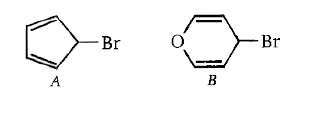Which of the following statement(s) is/are incorrect regarding SN1 reaction?
I) Rearrangement is possible.
II) Proceeds with complete inversion of configuration.
III) Rate depends on polarity of solvent.
IV) The strength of the nucleophile is important in rate determining step.
II,IV only
I, II, IV only
III only
I, II only
The correct Answer is:A
To determine which statements regarding the SN1 reaction are incorrect, let’s analyze each statement step by step.
Step 1: Understanding SN1 Mechanism
The SN1 reaction involves two main steps:
1. Formation of a carbocation (rate-determining step).
2. Nucleophilic attack on the carbocation.
Step 2: Evaluating Each Statement
Statement I: Rearrangement is possible.
- This statement is true. During the formation of the carbocation, if the carbocation is not stable, it can rearrange to form a more stable carbocation (e.g., through hydride or alkyl shifts).
Statement II: Proceeds with complete inversion of configuration.
- This statement is incorrect. SN1 reactions typically lead to a racemic mixture of products due to the planar nature of the carbocation, which allows the nucleophile to attack from either side, leading to both inversion and retention of configuration.
Statement III: Rate depends on polarity of solvent.
- This statement is true. The rate of an SN1 reaction is influenced by the polarity of the solvent because a polar solvent stabilizes the carbocation and the leaving group, thus facilitating the reaction.
Statement IV: The strength of the nucleophile is important in the rate-determining step.
- This statement is incorrect. In an SN1 reaction, the rate-determining step is the formation of the carbocation, which does not depend on the nucleophile's strength. The nucleophile's strength becomes relevant after the carbocation is formed.
Conclusion
Based on the analysis:
- Incorrect statements: II and IV.
- Correct statements: I and III.
Final Answer
The incorrect statements regarding SN1 reactions are:
- II) Proceeds with complete inversion of configuration.
- IV) The strength of the nucleophile is important in the rate determining step.
The SN1 reaction involves two main steps:
1. Formation of a carbocation (rate-determining step).
2. Nucleophilic attack on the carbocation.
Statement I: Rearrangement is possible.
- This statement is true. During the formation of the carbocation, if the carbocation is not stable, it can rearrange to form a more stable carbocation (e.g., through hydride or alkyl shifts).
- This statement is incorrect. SN1 reactions typically lead to a racemic mixture of products due to the planar nature of the carbocation, which allows the nucleophile to attack from either side, leading to both inversion and retention of configuration.
- This statement is true. The rate of an SN1 reaction is influenced by the polarity of the solvent because a polar solvent stabilizes the carbocation and the leaving group, thus facilitating the reaction.
- This statement is incorrect. In an SN1 reaction, the rate-determining step is the formation of the carbocation, which does not depend on the nucleophile's strength. The nucleophile's strength becomes relevant after the carbocation is formed.
Based on the analysis:
- Incorrect statements: II and IV.
- Correct statements: I and III.
The incorrect statements regarding SN1 reactions are:
- II) Proceeds with complete inversion of configuration.
- IV) The strength of the nucleophile is important in the rate determining step.
Topper's Solved these Questions
Similar Questions
Which of the following is//are the rate determining step (s) of the given reaction ?
 .
.
View SolutionWhich statement/s is/are incorrect regarding DNA ?
I. DNA has a double helix structure.
II. DNA can be double-stranded or single-stranded in animals
III. The two chains have parallel polarity.
IV. The pitch of the helix is 3.4 nm.
View Solution
Knowledge Check
Which of the following phrases are not correctly associated with Svi reaction ?
(1) Rearrangement is possible
(2) Rate is affected by polarity of solvent
(3) The strength of the nucleophile is important in determining rate
(4) The reactivity series is tertiary > secondary > primary
(5) Proceeds with complete inversion of configurationA3,5B5 onlyC2, 3, 5D3 onlyWhich of the following statement regarding SN1 reaction shown by alkyl halide is incorrect?
AThe added nucleophile plays no kinetic role in SN1 reaction.BThe SN1 reaction involves the inversion of configuration of the optically active substrate.CThe SN1 reaction on the chiral starting material ends up with racemisation of the product.DThe more stable the carbocation intermediate the faster the SN1 reaction.Which of the following statements is correct regarding the rate of hydrolysis of the compounds (A) and (B) by SN2 reaction ?
 AA reacts faster than BBB reacts faster than ACBoth A and B reacts at the same rateDNeither A nor B reacts
AA reacts faster than BBB reacts faster than ACBoth A and B reacts at the same rateDNeither A nor B reacts
Consider the ollowing statement about SN1 reaction
(i) it is a bimolecular reaction
(ii) it proceeds with retention as well as inversion of the configuration.
(iii) It involves the fomrationn of an intermediate cabocation
(iv) The reaction is carried in the presence of polar aprotic solvents
View Solution(i) Which alkyI hailde from the following pair is chiral and undergoes faster SN2 reaction ?

(ii) Out of SN1andSN2 which reaction occurs with
(a) Inversion of configuration
(b) Recemisation
View SolutionWhich of the following is correct order of σ - bond strength ?
I. 2s-2s
II. 2s-2p
III. 2p-2p
IV. 3s-3s
View SolutionWhich of the following is correct order of σ - bond strength ?
I. 2s-2s
II. 2s-2p
III. 2p-2p
IV. 3s-3s
View SolutionConsider the following statements:
Bridgehead halides are inerttowards both SN1andSN2 reactions (till oneofthe ringsize is eight member ring)
(2) The first step in both SN2 and E1 reactions is the same
(3) SN2 reactions proceed with total retention of configuration
(4) E2 eliminations are by the use of a solvent of low polarity and high concentration of a strong base
Which of the above statements are correct?
View Solution
